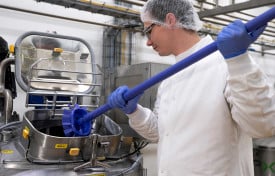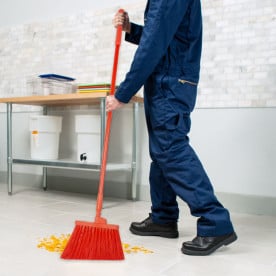Processing & Flow Control

- April 23, 2014
Navigate the intricacies of hose selection with confidence by leveraging our Hose Temperature & Pressure Reference Guide. Designed to be your go-to resource, this guide empowers you to make informed decisions tailored to the specific demands of your applications. Whether you're dealing with high temperatures, variable pressure environments, or both, this comprehensive reference guide provides clarity on which hoses are equipped to handle the heat and pressure levels required to get the job done. By consulting this invaluable tool, you can streamline the selection process, ensuring that your chosen hose not only meets but exceeds the temperature and pressure thresholds crucial for optimal performance. Don't leave these critical parameters to chance—utilize our Hose Temperature & Pressure Reference Guide to make confident, well-informed choices for your diverse hose applications.
- April 23, 2014
The ratings in this chart are based on the results of laboratory tests. They reflect the relative capabilities of various Teflon, silicone, PVC and rubber hose formulations to withstand specific chemicals. NOTE: The ratings in the chart DO NOT reflect the extent to which extraction may occur or the extent to which fluids may undergo any physical changes in properties or composition as a result of coming into contact with the hose. Saint-Gobain Performance Plastics makes no representation or warranty concerning the susceptibility of any fluid to become contaminated or undergo changes in properties or composition as a result of possible extraction of hose ingredients by the fluid to be transmitted. Certain corrosives that would be destructive to the hose with prolonged exposure can be satisfactorily handled for short periods if flushed with water after use. All ratings are based on room temperature (73°F). Chemical resistance will be adversely affected by elevated temperatures.
- April 23, 2014
Explore our informative chart on filtration ratings! It covers mesh sizes, micron values, and their corresponding inches. The chart details different filtration levels, from coarse to micro, showing what each mesh size can capture. Whether it's gravel, beach sand, or other tiny particles, this chart is a handy reference for anyone interested in filtration. It's an essential tool for understanding how filtration works across various materials.
- April 23, 2014
Discover the world of sanitary gaskets with our comprehensive range of flexible and non-toxic gasket compounds that adhere to stringent FDA specifications. Engineered for direct contact with dairy products and edible oils, these gaskets are also designed to meet the criteria set by 3-A, USDA, and NSF standards. Not only do they exhibit low-swell characteristics, making them well-suited for exposure to oils, steam, and water, but they also won't absorb taste or odors, ensuring the integrity of your products. Our gaskets are available in various materials, including the popular Buna-N, known for its oil resistance, EPDM for steam and hot water service, Viton with exceptional fluid resistance, silicone for outstanding low-temperature flexibility, and Teflon with an impressive temperature range. Each material comes with its unique set of properties, catering to specific application requirements. Shop with confidence, knowing that our gaskets are sold individually, and reach out to our knowledgeable
- April 23, 2014
Prevent premature Washdown hose wear and failure. Washdown hoses are often subjected to physical abuse
while in service. Select a hose that meets or exceeds the application it is intended for.Consider temperature, pressure, and environmental concerns such as abrasion and chemical resistance.
Every plant should have a maintenance/inspection plan in place to ensure the longest possible life of the hose.Be sure to consider these steps in your plan:
- Store hose properly when not in use. Hose racks or reels are highly recommended to keep hoses off the floor
and out of harms way. Pay attention to humidity, temperature, ozone and sunlight. Storing out of direct sunlight,
in a room with moderate humidity and a temperature range of 50° to 75°F is recommended. - Always shut off the water supply to the hose when not in use and open the nozzle to relieve the pressure before storing. Leaving water in the hose subjects it to constant pressure
- Store hose properly when not in use. Hose racks or reels are highly recommended to keep hoses off the floor
- April 22, 2014
Dive into a world of versatility with our extensive gasket line tailored for the unique demands of the food and beverage industries. At your fingertips, you'll find a diverse array of sizes, colors, and materials, meticulously chosen to meet the stringent requirements of these industries. Our commitment to providing comprehensive information is reflected in the Pipeline Gasket Reference Guide, a valuable resource offering insights into material options, temperature ranges, chemical resistance, tear resistance, durometer, and more. Whether you seek gaskets for specific temperature-sensitive applications or those resilient to various chemicals, our reference guide equips you with the knowledge needed to make informed decisions. Explore the possibilities, and discover the perfect gasket solution that aligns with your industry's standards and requirements.
- April 12, 2010
Available in Buna, Viton, EPDM, Teflon, and Silicone, color-coded gaskets can be manufactured in virtually any color for virtually any application. Color coded gasket programs are a great way to manage and monitor your plant maintenance schedules.
Annual color changes will allow your maintenance and production employees to immediately determine when the last time a gasket was changed as soon as the clamp is removed, making missed gaskets obvious. Color-coded programs help to ensure that gaskets are changed out regularly and that your piping connections are securely sealed to reduce the risk of leaks and product loss.
Color coded gaskets can also be used for designating production/product lines. Especially in congested piping configurations, complete line gasket changes become faster and easier. Employees can immediately see if they are working on the correct line based on the gasket color.
Interested in implementing a color coded gasket program? Call our customer






